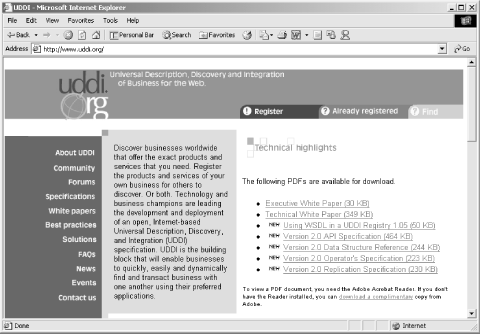
13.2. UDDI
With no further suspense, I want to define what UDDI is. It stands for Universal Discovery, Description, and Integration, and is most often associated with the word "registry." The primary place to learn about UDDI is its web site, http://www.uddi.org (shown in Figure 13-2), also the home of the UDDI registry that is so important in registering and locating services. This site describes the UDDI project, which seeks to create and define a complete framework for the exchange of data I've been talking about in this chapter. The initiative is supported by both IBM and Microsoft, so it looks like it's around for the long haul.

Figure 13-2. The UDDI web site
The core of this is the network of services about which UDDI stores information. The ability to register a new service and search for an existing one is part and parcel of this registry, and is available online at the UDDI web site. All that is required is a simple registration process. Neither IBM nor Microsoft require a company or even an individual to pay high fees to make their services publicly available. Because of this, there are many, many more services being registered every day than a "for-profit" system would engender.
That's all that there really is to UDDI. There is little complexity in the use of UDDI; the hard stuff is all in implementation, which you and I aren't really interested as a service provider or consumer. There are several UDDI implementations available that can be downloaded and run locally, and I prefer jUDDI over the others. You can check out this Java-based open source project at http://www.juddi.org. Additionally, IBM's web services toolkit (covered in Section 13.3, "WSDL" later in this chapter) includes a trial version of a private UDDI registry. I'm not going to cover jUDDI or the IBM UDDI registry here, because they don't aid in understanding how to use UDDI, but rather how to implement it. If you have an interest in seeing what drives a UDDI registry, I'd recommend you check out jUDDI. If you are just interested in writing web services and making them available to others, though, I wouldn't worry too much about it. Finally, I leave out the specifics of registering and searching for services until the final section, in which I walk you through a fairly complex real-world example using SOAP, UDDI, and WSDL.

Copyright © 2002 O'Reilly & Associates. All rights reserved.



